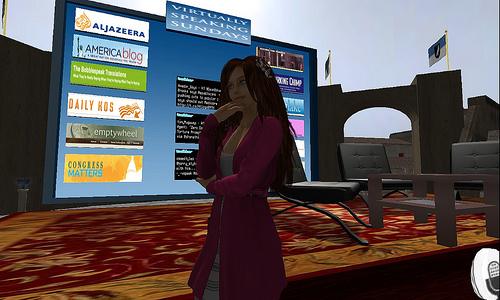
Survival of the fittest
We come now to the final question, which is trying to figure out, from so many possible models, which ones will survive, and which are just really “VC bait” and not serious propositions at doing business.
Keep in mind the old American saying: “You’ll be a millionaire if you’re the best at doing what you do; even if that’s just pushing trashcans”. It doesn’t matter if you are the most business-savvy one, have the best technology, have the best salesforce, the best programmers or content developers, or the best marketing. Ultimately, if you’re the best at any of those, you’ll succeed.
And this is where the players in the market are positioning themselves. Linden Lab has by far the advantage with Second Life: they have a business model that works (3D content hosting). They have the largest number of 3D digital content creators ever amassed by a company. They have a contiguous, immersive world (all large-scale virtual worlds, from World of Warcraft to Habbo Hotel, are “sharded”, ie. the world is different for different users, as they log in to different servers). They still have the best avatars, although things like realXtend or the upcoming Sony Home (if it ever gets launched) might finally surpass SL. They might not have the best technology — in the sense of stability and reliability — but they are raising the stakes very high by allowing streaming of all user-created content, and not only allowing pre-approved content as all the competitors do. And they have an edge in providing an immersive experience.
If you look at the closest competitors, they all tend to talk about the same thing: “this is not a separate environment, it’s an extension of your real life”. Although this was never used as a sales pitch before, it’s now commonplace. The marketeers apparently fear that people view their products as “alienation” or pure entertainment — which allegedly will make companies shun them for some reason. I have no clue if anyone did a market study on those, or if they’re just extrapolating from the success of MySpace and Facebook to show real people, with real pictures, talking about what they do in real life, and want to bring that into their products.
But is that so important?
Somehow, I feel that 14.5 million residents, 60,000 of which make a living out of Second Life, and at least with 100,000 active participants in the economy, couldn’t care less. For them, SL is an immersive experience, but they don’t care if it’s a “second life”, an extension of the first, or pure entertainment. They make Second Life a living world, with its own economy, a contiguous landscape, and a sense that we all are in the same environment together. Are they all wrong?
Apparently even Microsoft thinks they’re not. In fact, Microsoft just found out that they can engage the community (in their case, MS’s own developer community) inside Second Life and make the events well-attended and interesting for them, for a fraction of the cost. For us SL veterans, those aren’t news. The important thing is that Microsoft certainly has the ability, the technology, the developers, the resources, and the money to launch their own closed-content, restricted-access virtual world. So does IBM. And to an extent, that’s what Sun’s also doing with Wonderland running over Project Darkstar. So why is Microsoft in SL? One would expect that Microsoft, Queen of Closed Content (remember MSN in 1995?), would surely be the first to shun the open-minded quality of SL and launch their own, ActiveX-oh-it-runs-only-in-IE7-under-Vista-sorry-about-that virtual world?
But they don’t.
One would also expect that colleges and universities would just continue to work with OpenCroquet or any other academic-sprouted virtual world environment. After all, the complains about educators in SL are endless: from complains about their lack of powerful enough hardware to run SL, to the inability to go through their campus firewalls (and sometimes the problem of registering too many avatars behind the single IP of the campus router before SL limits the number of accounts coming from the same address), and the age problem, which excludes K-12 students to work together with their teachers on the same grid, and, more recently, the lack of proper HTML support on a prim (unlike all other VW technologies) to allow shared whiteboards and collaborative textual content on the classroom. Also, the cost of renting enough land for their projects is sometimes too high for the poor universities without enough resources or funding.
So why don’t they use any other, free technology?
Digital content creators have long lived from selling their content on popular artist’s communities like Renderosity. None of these sites are closed — they grow and grow, although their content has little use outside their community. Instead, these days, many are simply developing for Second Life. For the end user, the cost of a digital item done in SL is even slightly lower than what is being sold on those sites. But the difference is the amount of sales that you can manage in SL! Unlike the specialist sites, all residents in SL are avid consumers of digital content, and a fraction is even prepared to pay a bit for having good quality products. So SL managed to engage the mainstream users into consuming digital content.
Now, all these designers are a vast pool of labour that can be tapped for any other virtual world. Why don’t the other virtual world creators understand this, and instead, close the doors to user-generated content? Even Apple opened up their iPhone platform for third-party developers. Twitter’s not dead yet because, unlike Plurk, they have released an API and allow others to integrate with their (mostly broken) technology. The whole world is interfacing Jabber/Gtalk with Facebook with OpenSocial with OpenID; APIs are released every day for the most incredible products; we get widgets and applets to draw data from some sites and place it in others. The “interconnection mantra” that started long ago with RSS feeds (and probably even before that) dominates the market, as all vendors of web-based social environments attract programmers, developers, designers, and digital artists to create things that interact with their own products. “Mashup” is the meme of this decade.
So why do those virtual world start-ups insist on closed content, proprietary technology, and no way to allow interconnection with other tools or third-party content?
We can also be critical of Linden Lab’s slow adoption of engaged participants as co-developers of the technology; I mean, we’ve been crying for it for the past four or five years. Nevertheless, Second Life was designed from the start — like, say, MySpace — to fully allow users to generate their own content and interconnect with other people’s content (the permission system!), while at the same time, thanks to Lessig’s influence, protecting creators’ intellectual property rights. However, all this remained mostly Second Life’s legacy. Other companies don’t view any of the above as being important.
Why aren’t they learning the lesson of the old 2D social environments, who certainly are all about interconnection, third-party products, and mashups?



